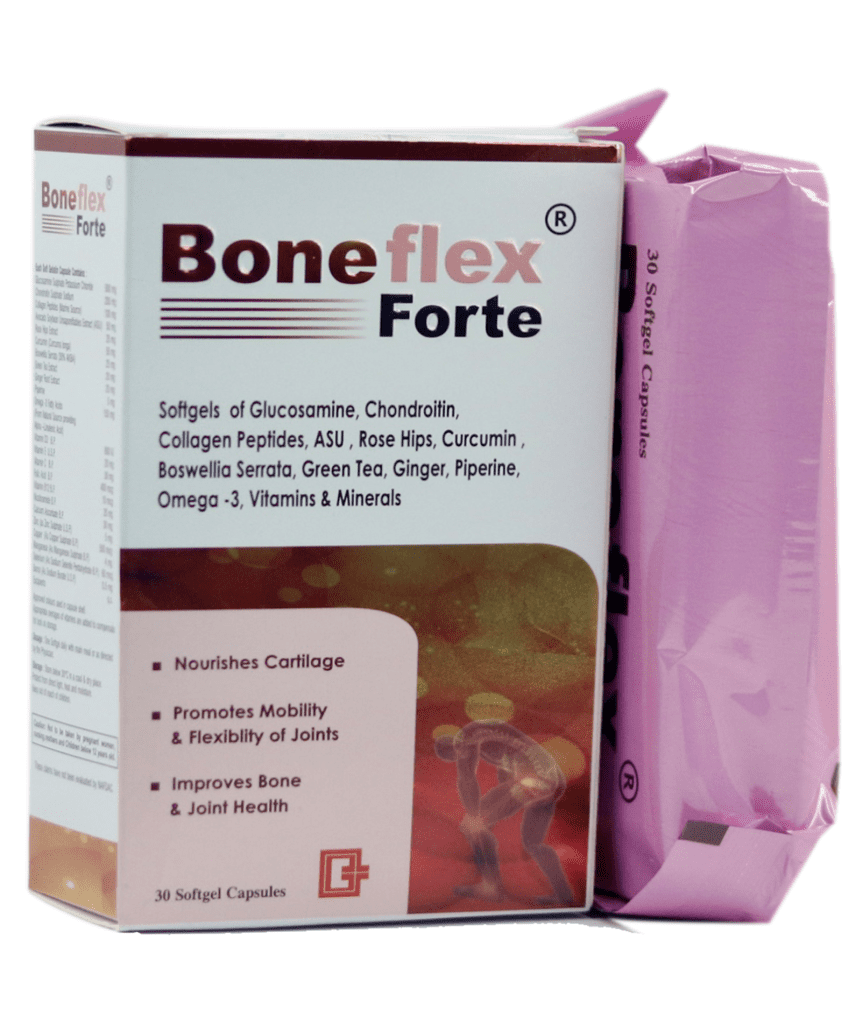Maintaining an active lifestyle can become increasingly challenging as joint pain and stiffness set in, especially for those experiencing osteoarthritis symptoms. Boneflex Forte is designed to help you keep moving by providing comprehensive joint health support through a blend of scientifically-proven ingredients that promote joint flexibility and joint function.
Glucosamine Sulphate and Chondroitin Sulphate are two foundational ingredients in Boneflex Forte. Glucosamine and chondroitin play a crucial role in building and maintaining cartilage health, the tissue that cushions joints. Studies have shown that these compounds can help reduce pain and improve joint function in people with osteoarthritis (Reginster et al., 2001). These key components are essential in osteoarthritis management, slowing the progression of joint deterioration (Hochberg et al., 2016).
Marine Collagen Peptides are another key component, known for their ability to support joint health by providing the necessary building blocks for cartilage repair. Research has demonstrated that collagen peptide supplementation can reduce joint pain and improve joint function, particularly in individuals suffering from osteoarthritis (Zhu et al., 2018). This makes them an excellent choice for those seeking joint support supplements.
Avocado Soybean Unsaponifiables (ASU) are known for their anti-inflammatory properties, which are crucial for managing joint inflammation. ASU has been shown to reduce pain and stiffness associated with osteoarthritis by blocking pro-inflammatory mediators and stimulating cartilage repair (Lequesne et al., 2002). This highlights the role of natural joint supplements like Boneflex Forte in promoting joint pain relief.
Boswellia Serrata, standardized to 30% AKBA (acetyl-11-keto-β-boswellic acid), is included for its potent anti-inflammatory effects. Clinical trials have shown that Boswellia Serrata can significantly reduce joint pain and improve physical function by inhibiting enzymes that cause inflammation and cartilage degradation (Kimmatkar et al., 2003). This makes it an essential ingredient in arthritis supplements focused on joint support.
Curcumin (Curcuma longa) and Ginger Root Extract are both well-known for their natural anti-inflammatory effects. Curcumin has been extensively studied for its ability to reduce inflammation and pain in joints (Henrotin et al., 2014), while ginger root extract has been found to alleviate pain and improve mobility in individuals with osteoarthritis (Bartels et al., 2015). These ingredients are key players in the realm of anti-inflammatory supplements.
Omega-3 Fatty Acids, particularly Alpha-Linolenic Acid, help reduce inflammation and support joint health. Omega-3 fatty acids have been shown to alleviate symptoms of rheumatoid arthritis and may help reduce the need for anti-inflammatory medications (Calder, 2006). Combined with Vitamin D3, which is crucial for bone health and calcium absorption, these ingredients work together to maintain overall joint and bone health, making Boneflex Forte a well-rounded natural joint supplement.

The inclusion of Green Tea Extract and Piperine in Boneflex Forte further enhances its efficacy. Green tea extract provides powerful antioxidant benefits, protecting joint tissues from oxidative stress (Chowdhury et al., 2016). Piperine, derived from black pepper, enhances the bioavailability of other nutrients, ensuring that your body absorbs and utilizes the ingredients in Boneflex Forte effectively (Shoba et al., 1998).
Boneflex Forte also contains essential vitamins and minerals like Vitamin E, Vitamin C, Zinc, and Copper, all of which play a role in maintaining joint health by supporting collagen synthesis, reducing oxidative stress, and promoting tissue repair.
In conclusion, Boneflex Forte combines these scientifically-supported ingredients to offer a comprehensive solution for joint pain relief, helping you maintain an active lifestyle despite the challenges of aging or joint-related conditions. Whether you're dealing with osteoarthritis symptoms or simply looking to enhance joint flexibility and joint function, Boneflex Forte is a powerful ally in your journey toward optimal joint health.
References:
Reginster, J. Y., et al. (2001). Glucosamine sulfate significantly reduces the progression of knee osteoarthritis over 3 years: a large, randomized, placebo-controlled, double-blind, prospective trial. Arthritis & Rheumatism.
Hochberg, M. C., et al. (2016). Pharmacologic therapy for osteoarthritis: update of the 2019 American College of Rheumatology. Arthritis Care & Research.
Zhu, S., et al. (2018). Efficacy of collagen peptide supplementation in treating symptomatic osteoarthritis: a systematic review and meta-analysis. Clinical Interventions in Aging.
Lequesne, M., et al. (2002). Structural effect of avocado/soybean unsaponifiable on joint space loss in osteoarthritis of the hip. Arthritis & Rheumatism.
Kimmatkar, N., et al. (2003). Efficacy and tolerability of Boswellia serrata extract in treatment of osteoarthritis of the knee--a randomized double blind placebo controlled trial. Phytomedicine.
Henrotin, Y., et al. (2014). Biological actions of curcumin on articular chondrocytes. Osteoarthritis and Cartilage.
Bartels, E. M., et al. (2015). Efficacy and safety of ginger in osteoarthritis patients: a meta-analysis of randomized placebo-controlled trials. Osteoarthritis and Cartilage.
Calder, P. C. (2006). n−3 polyunsaturated fatty acids, inflammation, and inflammatory diseases. The American Journal of Clinical Nutrition.
Chowdhury, D., et al. (2016). Green tea extract: a potent chemopreventive agent in murine skin carcinogenesis model induced by UVB radiation. Biomedicine & Pharmacotherapy.
Shoba, G., et al. (1998). Influence of piperine on the pharmacokinetics of curcumin in animals and human volunteers. Planta Medica.
Article Written By
Pharmacist Somtochukwu Chimbiko


